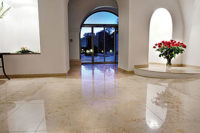A multi-functional space
Formerly the Midwest Headquarters of National Cash Register, the property at 1112 Olive Street is now known as The Cosmopolitan, and it houses an upscale residential loft as well as multiple office spaces, an entertainment space and an elaborate display of the owner’s collectable signage and memorabilia.
“It was built for National Cash Register in 1928 in an American Gothic style,” Pitliangas said. “When I purchased the building in 2000, we knew that we wanted to go with a Gothic look. We wanted a 14th or 15th century castle type of feel. We also wanted to make sure that the interior would reflect the architecture on the outside.”
In decorating the interior of The Cosmopolitan, Pitliangas selected a range of high-end elements — many of them antiques — for features such as lighting, wall treatments and furnishings. “The bar is actually an antique from Chicago, and we retrofit it for our bar area.”
But in addition to bringing in antiques, Pitliangas relied on his company’s unique skills to give The Cosmopolitan a signature look. This included the production of custom-etched glass, and one-of-a-kind, decorative tilework. These tile designs can be found at virtually every level of the building, and they depict everything from floral patterns to portraits of William Shakespeare and Dr. Seuss.
“We use a lot of fired tile/stoneware,” Pitliangas explained. “Nothing is machined. We mask it off and do everything freehand. It is sandblasted, then glazed and then fired.
We might end up going with five or more glazes for a single piece; each one is unique. We might also have different firings at different temperatures, especially when we are using gold, silver and metallics. We fire at lower temperatures for gold and metals.”
Custom tilework can be found as soon as guests approach the exterior of The Cosmopolitan, where the oak woodwork and etched glass at the ground level are flanked by two ornate custom displays of tilework at each end.
In addition to the tile artwork, elements such as tile and stone flooring can be found throughout The Cosmopolitan. “I love using stone and wood; they never go out of style,” Pitliangas said.
The use of stone is particularly prominent in the residential loft, which includes 3,000 square feet of living space and took two years to complete. Scabos travertine flooring begins at the entrance to the loft, and a cultured stone archway leads to the living area, where the William Shakespeare tile portrait is prominently displayed.
The centerpiece of the loft’s living space is a grand fireplace, which was carved from hand-selected Italian marble and features a two-tiered hearth that uses multiple stone materials.
In the kitchen, countertops of Giallo Veneziano marble and stainless steel Viking appliances are complemented by a custom-made tile backsplash that depicts the Royal coat of arms of the United Kingdom, with imagery of the lion, unicorn and crown.
The loft’s bathroom also combines natural stone and custom tilework, as the Rosso Levanto marble vanity is topped by a floral tile pattern for the backsplash.
Recreating a neighborhood
One-of-a-kind displays of artistic tilework were also a key component of the restoration of another historic building across the street from The Cosmopolitan at 1009 Olive Street. Formerly the Eastman Kodak Building, Pitliangas renamed the structure “The Thaxton,” and it serves as a highly sought-after space for weddings and other cocktail style events. It also houses office space as well as “Speakeasy at The Thaxton,” an upscale bar/nightclub for public and private events.
One of only two Art Deco buildings in Downtown St. Louis, The Thaxton is listed on the National Register of Historic places, and the renovation and restoration project revived the building’s Art Deco appeal while also adding new design elements. “I would say that The Thaxton is more Art Deco today than it was when it originally opened,” Pitliangas said.
Among the new design elements at The Thaxton, Antique Architectural Decor created custom, hand-crafted etched glass and decorative tilework. One particular design in tile features The Thaxton’s logo in a tropical, Art Deco style, surrounded by Rainforest Brown and Rosso Levanto marble. In a more whimsical use of custom tilework, the men’s and women’s bathrooms in the bar area are identified by tile “playing cards” representing a king and queen.
Since its completion, The Thaxton has been well reviewed by the local media, with Ashley Rath of StLouisWeddingPlanner.com offering the following write-up: “If you’re looking for something a little more edgy, not your run-of-the-mill wedding venue, The Thaxton is the place. With three different levels of lounging goodness, The Thaxton Building has a super retro setting for a more intimate affair. Kim Pitliangas, one of the Thaxton partners, was kind enough to show me around the space, and it is unlike anything I have seen in downtown. The historic Thaxton Building is unsurpassed in elegance and edginess.”
It was also named a 2011 “Best of Weddings” pick by TheKnot.com, a popular Web site for wedding planning.












